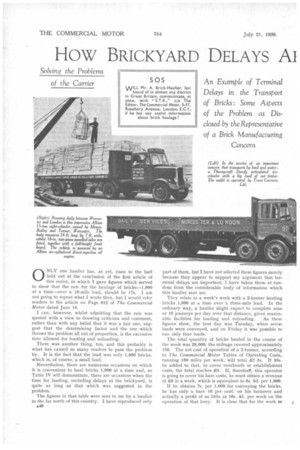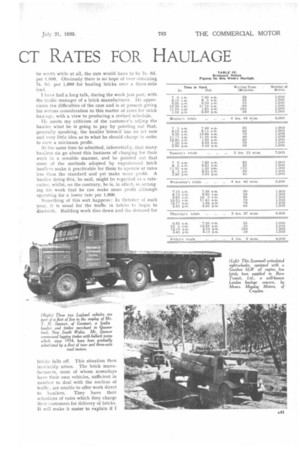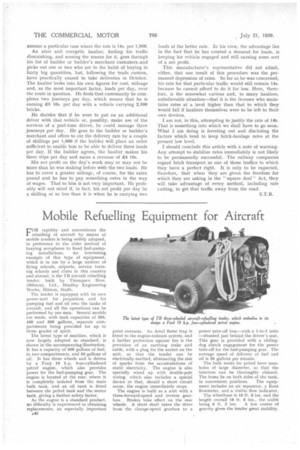How BRICKYARD DELAYS Al
Page 50

Page 51

Page 52

If you've noticed an error in this article please click here to report it so we can fix it.
CT RATES FOR HAULAGE
An Example of Terminal Delays in the Transport of Bricks: Some Aspects of the Problem as Disclosed by the Representative of a Brick Manufacturing
Concern
0 NLY one haulier has, as yet, risen to the bait held out at the conclusion of -the first article of this series, in which I gave figures which served to show that the rate for the haulage of bricks-1,000 at a time—over a 10-mile lead, should be 17s. I am not going to repeat what I wrote then, but I would refer readers to the article on Page 612 of The Commercial Motor dated June 16.
I can, however, whilst admitting that the rate was quoted with a view to drawing criticism and comment, rather than with any belief that it was a fair one, suggest that the determining factor and the one which throws the problem all out of proportion, is the excessive time allowed for loading and unloading.
There was another thing, too, and this probably is what has caused so many readers to pass the problem by. It is the fact that the load was only 1,000 bricks, which is, of course, a small load.
Nevertheless, there are numerous occasions on which it is convenient to haul bricks 1,000 at a time and, as Table IV will demonstrate, there are occasions when the time for loading, including delays at the brickyard, is quite as long , as that which was suggested in the problem.
The figures in that table were sent to me by a haulier in the far north of this country. I have reproduced only A40 part of them, but I have not selected these figures merely because they appear to support my argument that terminal delays are important; I have taken them at random from the considerable body of information which this haulier sent me.
They relate to a week's work with a 2-tonner hauling bricks 1,000 at a time over a three-mile lead. In the ordinary way, a haulier might expect to complete nine or 10 journeys per day over that distance, given reason
able facilities for loading and unloading. As these figures show, the best day was tuesday, when sevcai loads were conveyed, and on Friday it was possible to run only four loads.
The total quantity of bricks hauled in the course of the week was 28,000; the mileage covered approximately 150. The net cost of operation of a 2-tonner, according to The Commercial Motor Tables of Operating Costs, running 150 miles per week, will total 27 5s. If 35s. be added to that, to cover overheads or establishment costs, the total reaches 29. If, therefore, this operator is going to cover his bare costs, he must obtain a revenue of 29 in a week, which is equivalent to 6s. Sd. per 1,000.
If he obtains 7s. per 1,000 for conveying the bricks, he has only a bare 10 per cent, on his turnover and actually a profit of as little as 16s. 4d. per week on the operation of that lorry. It is clear that for the work to be worth while at all, the rate would have to be 7s. 6d. per 1,000. Obviously there is no hope of ever obtaining 7s. 01. per 1,000 for hauling bricks over a three-mile lead.
1 have had a long talk, during the week just past, with the traffic manager of a brick manufacturer. He appreciates the difficulties of the case and is at present giving his serious consideration to this matter of rates for brick haulage, with a view to producing a revised schedule.
Flu meets my criticism of the customer's telling the haulier what he is going to pay by pointing out that, generally speaking, the haulier himself has no set rate and very little idea as to what he should charge in ordei to earn a minimum profit.
At the same time he admitted, inferentially, that many hauliers do go about this business of charging for their work in a sensible manner, and he pointed out that some of the methods adopted by experienced brick hauliers make it practicable for them to operate at rates less than the standard and yet make more p:ofit. A haulier doing this, he said, might be regarded as a rateculler, whilst, on the contrary, he is, in effect, so arranging his work that he can make more profit although operating for a lower rate per 1,000.
Something of this sort happens : In October of each year, it is usual for the traffic in bricks to begin to diminish. Building work dies down and the demand for bricks falls off. This situation then inevitably. arises. The brick manufacturers, most of whom nowadays have their own vehicles, sufficient in number to deal with the nucleus of traffic, are unable to oiler work direct to hauliers. They have their schedules of rates which they charge their customers for delivery of bricks. It will make it easier to explain if I assume a particular case where the rate is 14s. per 1,000.
An alert and energetic haulier, finding his traffic diminishing, and sensing the reason for it, goes through his list of builder or builder's merchant customers-and picks out one or two who are in the habit of buying in fairly big quantities, but, following the trade custom, have practically ceased to take deliveries in October. The haulier looks into his own figures for cost, mileage and, as the most important factor, loads per day, over the route in question. He finds that customarily he completes two journeys per day, which means that he is earning £3 10s. per day with a vehicle carrying 2,500 bricks.
He decides that if he were to put on an additional driver with that vehicle or, possibly, make use of the services of a part-time driver, he could manage three journeys per day. He goes to the builder or builder's merchant and offers to cut the delivery rate by a couple of shillings per 1,000 if the builder will place an order sufficient to enable him to be able to deliver three loads per day. 11 the builder agrees, the haulier makes his three trips per day and earns a revenue of £4 10s.
His net profit on the day's work may or may not be more than he was making before with the two loads. He has to cover a greater mileage, of course, for the extra pound and he has to pay something extra in the way of wages. That to him is not very important. He probably will not mind if, in fact, his net profit per day be a shilling or so less than it is when he is carrying two
loads at the better rate. In his view, the advantage lies in the fact that he has created a demand for loads, is keeping his vehicle engaged and still earning some sort of a net profit.
This manufacturer's representative did not admit, either, that one result of this procedure was the permanent depression of rates. So far as he was concerned, his rate for that particular traffic would still remain 14s. because he cannot afford to do it for less. Here, therefore, is the somewhat curious and, to many hauliers, unbelievable situation—that it is the licensee who maintains rates at a level higher than that to which they would fall if hauliers themselves were to be left to their own devices.
I am not, in this, attempting to justify the rate of 14s. That is something into which we shall have to go soon. What I am doing is ferreting out and disclosing the factors which tend to keep brick-haulage rates at the present low level.
I should conclude this article with a note of warning. Any attempt to stabilize rates immediately is not likely to be permanently successful. The railway companies regard brick transport as one of those traffics to which they have a perfect right. It is only to be expected, therefore, that when they are given the freedom for which they are asking in the "square deal" Act, they will take advantage of every method, including rate cutting, to get that traffic away from the road.
S.T.R.












































































